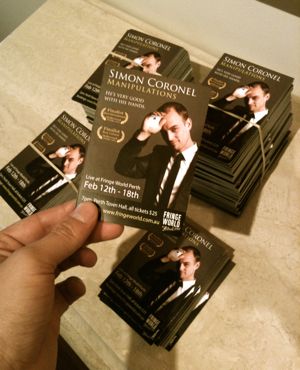A7 Flyers – The Guerrilla Marketing Secret Weapon
 When promoting a show, if you're going to follow the rule of "give a flyer to every person you interact with", then you need to have flyers on you at all times. Conventional DL-sized flyers or postcards make this tricky unless you're carrying a bag, and even then there will be moments when you're bag-free and flyerless.
When promoting a show, if you're going to follow the rule of "give a flyer to every person you interact with", then you need to have flyers on you at all times. Conventional DL-sized flyers or postcards make this tricky unless you're carrying a bag, and even then there will be moments when you're bag-free and flyerless.
The best flyer approach I've found is to design your flyers in A7 size, and print them on the thickest cardstock you can find. 300gsm minimum, with a matte laminate finish. (In case you don't know, A7 is an international standard paper size equal to 1/8 of an A4 sheet.) It's about the smallest standard size you can go without it getting confusing. I actually experimented once with getting ultra-small 90x55mm flyers printed, but too many people just thought I was giving them a business card.
(Note for America: A7 is about 3 x 4.2in. Please hurry up and get your country onto the A-series paper system like the rest of the known universe; it makes life a thousand times easier than the horrible letter/legal/what-the-hell-is-wrong-with-this-printer system.)
If you go the thick A7 flyer route, you have a number of advantages over conventional flyers:
1) You can always have them on you.
As mentioned above, this has the significant advantage of always being ready to give out flyers to everyone. A7s will fit into a jacket or trouser pocket easily, so you can make sure you're never short of promotional materials.
2) They feel extra solid, and hence valuable.
For any given paper thickness, the smaller the flyer the more solid it will feel. If you get a coated 300gsm or 400gsm flyer, it will feel roughly twice as sturdy at A7 size than A6. As many people know, thicker cardstock makes the card feel more valuable, and hence makes the thing it's representing seem more valuable. A coated 400gsm A7 flyer, while technically no thicker than the same stock in A5, feels almost more like a solid object than a flyer. It helps make an impression.
3) Nobody folds them.
This is a small but significant point. If someone has to fold your flyer in order to keep it (i.e. anyone not carrying a bag, i.e. most men), it subtly devalues it psychologically. Particularly if it's printed on nice quality cardstock, a crease down the centre of the flyer makes it look more like a piece or rubbish than a valued object. It's only a small thing, but your flyer is the main representation of your show. If someone has to damage it, it's slightly lessening its perceived importance.
4) They stand out from the rest.
In the sea of thin paper DL flyers or generic postcards, the smaller high quality A7 flyers stand out from the others simply because they're different. Having given out close to 10,000 of these things over the years, people regularly respond positively to them as cute, quirky, interesting, or more convenient.
5) It's easier to give people a bunch of them.
As you go about promoting your show, you'll frequently run into lovely, wonderful people who are enthused by your show, and willing to take a few extra flyers to give to their friends, family, or co-workers. Much like point #1 above, the smaller size makes it easier for your newly recruited volunteer promoter to carry them with him or her as well, and keep spreading the word about the show.
6) They're cheaper.
Relatively speaking, at least. If you're springing for thick cardstock with a nice coating and full colour printing on both sides, you're going to be spending far more than on generic thinner flyers anyway. However, if you've committed to the nicer quality (as you should), A7s will be close to half the price of A6s at most printing places.
So, there are a bunch of the benefits I've encountered over the course of many shows. To be fair, there is one significant disadvantage to the A7 flyers. Specifically, they don't stand out as well when sitting on a table with a heap of other (usually larger) flyers. Hence they're not so good for leaving at restaurants or in the theatre lobby along with other shows' flyers.
Other than that though, they're one of the most effective face-to-face marketing aids I've ever encountered.



Brian Gillis’ card has a pre-indented fold in it. What do you think of this idea?
I think it works brilliantly for a business card, though I probably wouldn’t use it for a show promo flyer. On the other hand, it would definitely stand out even more from all the other generic uncreased flyers…